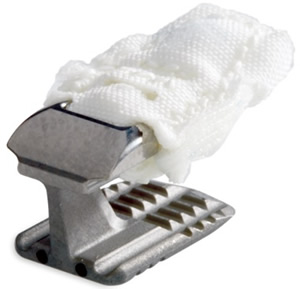
Barricaid Annular Closure Device
Several recently approved devices have the potential to improve outcomes for service members and veterans with musculoskeletal injuries. Additional promising devices and procedures are now in testing.
Some notable innovations include:
Barricaid Annular Closure Device: Approved for use following lumbar discectomy, Barricaid is designed to close annular defects of at least 6 mm in width to reduce the incidence of reherniation. Reherniation occurs in about 10% of lumbar discectomies among service members.1, and in 25% of lumbar discectomies when only looking at the large defect patient population. The device consists of a polyester fabric which is designed to close the opening in the annulus. A titanium anchor affixes the device to the adjacent vertebral bone for secure fixation.
First annular closure technology to receive FDA PMA approval: In February 2019, the Food and Drug Administration approved the Barricaid annular closure device to reduce the chance of reherniation at the specific level (L4-S1) from occurring, adding that, after a three-year follow-up in a clinical study, patients receiving the Barricaid device had significantly fewer reherniations.
It is designed to close the hole in a patient’s intervertebral disc following a limited discectomy procedure in the lower back (L4-S1) after an initial herniated disc. To do that, it rests in the disc space to reduce the number of potential reherniations.
According to the FDA, the product is indicated for patients with a numbness or weakness that extends to the buttock or legs—with or without back pain— caused by a herniation that is pinching a nerve root in the spine at one level between L4 and S1 that requires a limited discectomy procedure.
If it is determined during the surgery that the size of the hole left when the ruptured portion of the disc is removed is between 4-6 mm tall and 6-10 mm wide, the surgeon can implant the Barricaid, according to the approved labeling. If the hole is not large, then the likelihood for another herniation or operation is naturally lower, and the patient does not qualify for use of this device.
For complete risk-benefit information: www.barricaid.com/instructions-for-use
activL Artificial Disc with Intelligent Motion Technology: This third generation artificial disc can be implanted in the lumbar region in a single step. The mobile core enables more natural translational and rotational movement, while providing mechanical stability.
Bridge-enhanced ACL repair (BEAR): The BEAR implant uses a bio-engineered sponge to create a bridging scaffold into which the torn ends of the ACL are stitched. Healing is stimulated by applying the patient’s blood to the scaffold. Instead of requiring an autograft with another tendon, the scaffold enables a torn ACL to repair itself, returning to comparable strength and structure as the ACL in the uninjured knee. 2
1 Fredericks DR, Colantonio DF, Wagner S, Helgeson MD. 185. Reoperation rates after single-level lumbar discectomy in the military health system. The Spine Journal. Sept 2019;19(9):S89-S90.
2 Murray MM, et al. Abstract 7. Presented at: Arthroscopy Association of North American and American Orthopaedic Society for Sports Medicine Specialty Day at the American Academy of Orthopaedic Surgeons Annual Meeting; March 16, 2019; Las Vegas.
